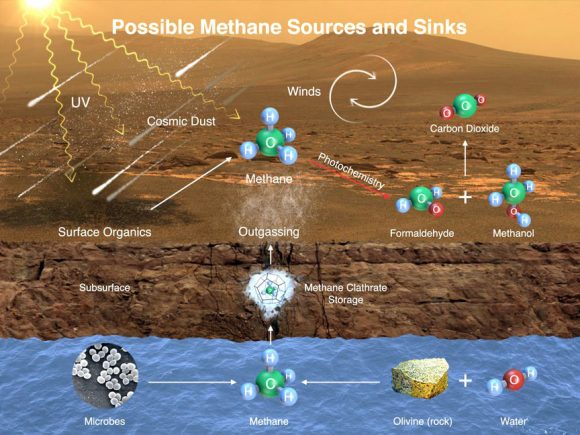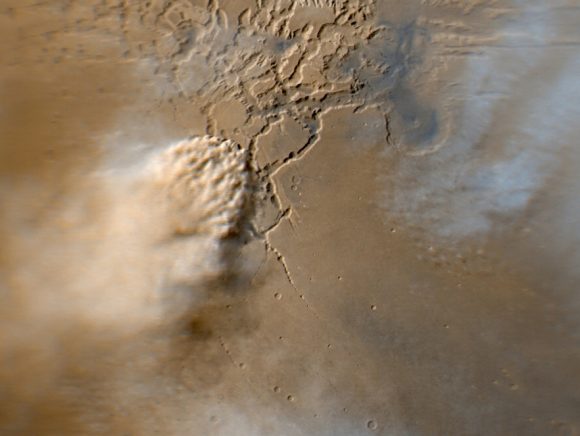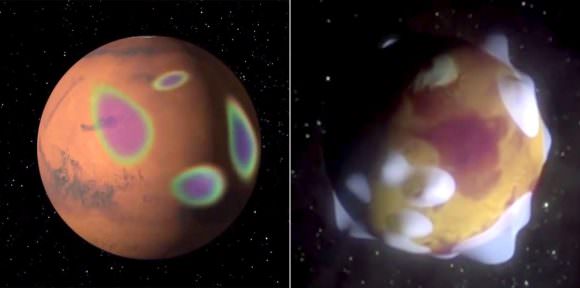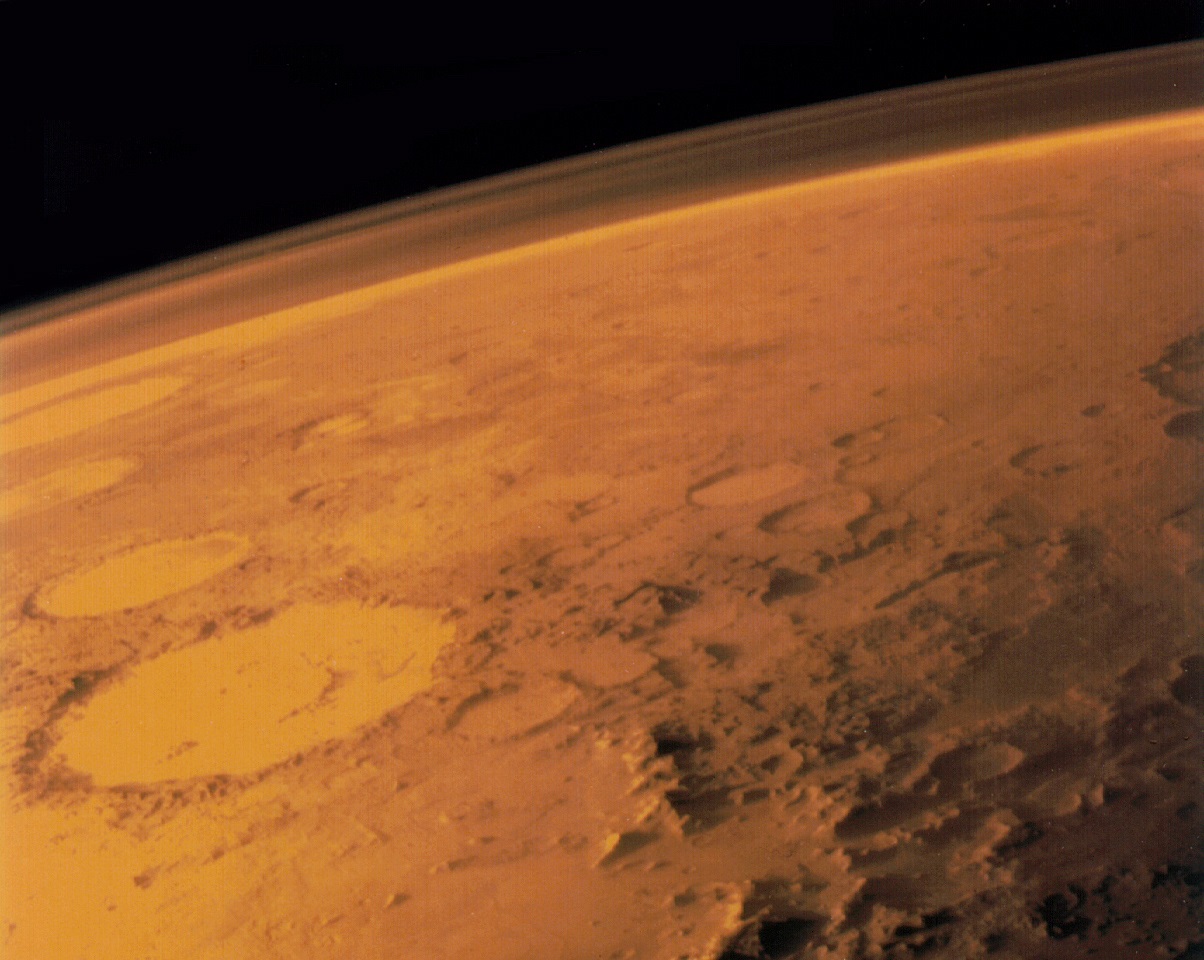Welcome back to our planetary weather series! Today, we take a look at Earth’s neighbor and possible “backup location” for humanity someday – Mars!
Mars is often referred to as “Earth’s Twin”, due to the similarities it has with our planet. They are both terrestrial planets, both have polar ice caps, and (at one time) both had viable atmospheres and liquid water on their surfaces. But beyond that, the two are quite different. And when it comes to their atmospheres and climates, Mars stands apart from Earth in some rather profound ways.
For instance, when it comes to the weather on Mars, the forecast is usually quite dramatic. Not only does Martian weather vary from day to day, it sometimes varies from hour to hour. That seems a bit unusual for a planet that has an atmosphere that is only 1% as dense as the Earth’s. And yet, Mars manages to really up the ante when it comes to extreme weather and meteorological phenomena.
Mars’ Atmosphere:
Mars has a very thin atmosphere which is composed of 96% carbon dioxide, 1.93% argon and 1.89% nitrogen, along with traces of oxygen and water. The atmosphere is quite dusty, containing particulates that measure 1.5 micrometers in diameter, which is what gives the Martian sky its tawny color when seen from the surface. Mars’ atmospheric pressure ranges from 0.4 to 0.87 kPa, which is the equivalent of about 1% of Earth’s at sea level.

Because of this thin atmosphere, and its greater distance from the Sun, the surface temperature of Mars is much colder than what we experience here on Earth. The planet’s average temperature is -63 °C (-82 °F), with a low of -143 °C (-226 °F) during the winter at the poles, and a high of 35 °C (95 °F) during summer and midday at the equator.
Due to the extreme lows in temperature at the poles, 25-30% of the carbon dioxide in the atmosphere freezes and becomes dry ice that is deposited on the surface. While the polar ice caps are predominantly water, the Martian North Pole has a layer of dry ice measuring one meter thick in winter, while the South Pole is covered by a permanent layer that is eight meters deep.
Trace amounts of methane and ammonia have also been detected in the Martian atmosphere. In the case of the former, it has an estimated concentration of about 30 parts per billion (ppb), though the Curiosity rover detected a “tenfold spike” on December 16th, 2014. This detection was likely localized, and the source remains a mystery. Similarly, the source of ammonia is unclear, though volcanic activity has been suggested as a possibility.
Meteorological Phenomena:
Mars is also famous for its intense dust storms, which can range from small tornadoes to planet-wide phenomena. Instances of the latter coincide with dust being blown into the atmosphere, causing it to be heated up from the Sun. The warmer dust-filled air rises and the winds get stronger, creating storms that can measure up to thousands of kilometers in width and last for months at a time. When they get this large, they can actually block most of the surface from view.

Due to its thin atmosphere, low temperatures and lack of a magnetosphere, liquid precipitation (i.e. rain) does not take place on Mars. Basically, solar radiation would cause any liquid water in the atmosphere to disassociate into hydrogen and oxygen. And because of the cold and thin atmosphere, there is simply not enough liquid water on the surface to maintain a water cycle.
Occasionally, however, thin clouds do form in the atmosphere and precipitation falls in the form of snow. This consists primarily of carbon dioxide snow, which has been observed in the polar regions. However, small traces of frozen clouds carrying water have also been observed in Mars’ upper atmosphere in the past, producing snow that is restricted to high altitudes.
One such instance was observed on September 29th, 2008, when the Phoenix lander took pictures of snow falling from clouds that were 4 km (2.5 mi) above its landing site near the Heimdal Crater. However, data collected from the lander indicated that the precipitation vaporized before it could reach the ground.
Aurorae on Mars:
Auroras have also been detected on Mars, which are also the result of interaction between magnetic fields and solar radiation. While Mars has little magnetosphere to speak of, scientists determined that aurorae observed in the past corresponded to an area where the strongest magnetic field is localized on the planet. This was concluded by analyzing a map of crustal magnetic anomalies compiled with data from Mars Global Surveyor.

A notable example is the one that took place on August 14th, 2004, and which was spotted by the SPICAM instrument aboard the Mars Express. This aurora was located in the skies above Terra Cimmeria – at geographic coordinates 177° East, 52° South – and was estimated to be quite sizable, measuring 30 km across and 8 km high (18.5 miles across and 5 miles high).
More recently, an aurora was observed on Mars by the MAVEN mission, which captured images of the event on March 17th, 2015, just a day after an aurora was observed here on Earth. Nicknamed Mars’ “Christmas lights”, they were observed across the planet’s mid-northern latitudes and (owing to the lack of oxygen and nitrogen in Mars’ atmosphere) were likely a faint glow compared to Earth’s more vibrant display.
To date, Mars’ atmosphere, climate and weather patterns have been studied by dozens of orbiters, landers, and rovers, consisting of missions by NASA, Roscomos, as well as the European Space Agency and Indian federal space program. These include the Mariner 4 probe, which conducted the first flyby of Mars – a two-day operation that took place between July 14th and 15th, 1965.
The crude data it obtained was expanded on by the later later Mariner 6 and 7 missions (which conducted flybys in 1969). This was followed by the Viking 1 and 2 missions, which reached Mars in 1976 and became the first spacecraft to land on the planet and send back images of the surfaces.
Since the turn of the century, six orbiters have been placed in orbit around Mars to gather information on its atmosphere – 2001 Mars Odyssey, Mars Express, Mars Reconnaissance Orbiter, MAVEN, Mars Orbiter Mission and ExoMars Trace Gas Orbiter. These have been complimented by rover and lander missions like Pheonix, Spirit and Opportunity, and Curiosity.
In the future, several additional missions are scheduled to reach the Red Planet, which are expected to teach us even more about its atmosphere, climate and weather patterns. What we find will reveal much about the planet’s deep past, its present condition, and perhaps even help us to build a future there.
We have written many interesting articles about Martian weather here at Universe Today. Here’s Mars Compared to Earth, It Only Happens on Mars: Carbon Dioxide Snow is Falling on the Red Planet, Snow is Falling from Martian Clouds, Surprise! Mars has Auroras Too! and NASA’s MAVEN Orbiter Discovers Solar Wind Stripped Away Mars Atmosphere Causing Radical Transformation.
For more information, check out this NASA article about how space weather affects Mars.
Finally, if you’d like to learn more about Mars in general, we have done several podcast episodes about the Red Planet at Astronomy Cast. Episode 52: Mars, and Episode 91: The Search for Water on Mars.
Sources:


Did you mean “crisscross” instead of “cross cross”?
pretty cool
Just wondering, if there are “patches” of magnetic field on the surface of Mars, would these be places that are more protected from cosmic radiation and solar winds?
So why do people want to go there to live?
It gave me an error and didn’t seem to upload the first one. Sorry! There’s no ‘delete’…
UT used to have an edit function in the comments. No mas..
Because, Bill Nye. 😉
Thanks for posting this video Jaffrey Borst. Bill Nye is my kind of guy as he is a great communicator for science and space exploration.
Venus is Earth’s twin.. Mars is Earth’s little brother. The Moon her baby sister? The highest temperature recorded on Mars is more like 70* F, not 95* F as reported above.
Be wise to put any scientific base or colony in the largest or strongest mag. field surface anomaly’s to use whatever extra E/M radiation protection it may provide? Even better would be to come up with a way to enhance those existing remnant mag. fields somehow. Fission powered electro magnets anyone?
No, Venus is Earth’s “Sister Planet”, and Mars is the twin! 😉 I know, its not exactly clear or consistent, but that’s how nicknames go.
As for highest temperatures, 95 F is an accurate reading, which was provided by the Spirit Rover.
http://mars.nasa.gov/mer/spotlight/20070612.html